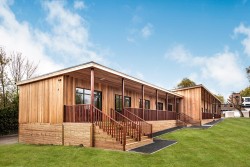Is the road to a net zero future a well mapped out route or is there uncertainty along the way? Richard Hipkiss, Development Director of the Modular and Portable Building Association (MPBA) makes the case for volumetric buildings shaping a more sustainable future.
Since the government amended the Climate Change Act in 2019 to commit the UK to achieving net zero carbon emissions by 2050, the construction industry has been confronted with the need to decarbonise.
According to the World Green Building Council, construction and buildings in use are responsible for 39% of all carbon emissions in the world. This is broken down into two elements with 11% being linked to the manufacture of materials and construction processes known as ‘embodied carbon’ emissions and 28% associated with ‘operational emissions’ caused by heating, cooling and lighting systems when a building is in use.
The challenge is therefore two-fold. Whilst there has been a drive to reduce operational emissions through the implementation of government legislation such as the changes to Part L of Building Regulations to improve the building fabric – little has been done to address the carbon inefficiencies in the construction process.
It is now established that volumetric modular approaches are a game changer for the construction industry – reducing build times whilst increasing quality, productivity and safety. But what is not so widely understood is that compared to traditionally built projects it is much easier to control energy use in factory settings than in an open construction site. On average 67% less energy is required to produce a volumetric manufactured building and up to 50% less time is spent onsite, resulting in up to 90% fewer vehicle movements which again reduces carbon emissions.
Volumetric manufactured buildings are digitally designed and virtually tested before they move onto the manufacturing phase. This process eliminates waste and achieves highly accurate and airtight building envelopes designed and built to higher sustainability requirements.
Unlike factory manufactured buildings, there is significant evidence that traditional construction methods do not produce buildings that perform as well as design expectations and there is a void between anticipated and actual in-use performance. Findings from studies such as PROBE (Post Occupancy Review of Buildings and their Engineering) reveal that actual energy consumption in buildings is often as much as twice of that predicted in the design.
Not only is the actual construction of the building ‘greener’ but volumetric manufactured buildings are also more energy efficient – reducing primary energy requirements and in-use operational emissions during the lifetime of the building. As the construction sector develops to meet changing government strategies, I firmly believe the upward trajectory of volumetric modular buildings will continue as the benefits begin in the factory, continue to the construction site and last through the lifetime of the building.
For more information visit: www.mpba.biz
Read the full article, go to Offsite Magazine









